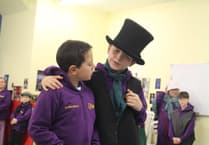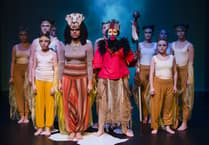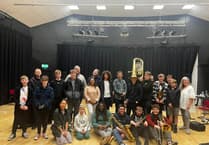An exhibition to showcase the artistic talents of visually impaired individuals was well-attended at the weekend.
The event, at charity Sight Matters’ Corrin Court base in Onchan displayed artwork from members, some of whom created the art before they became visually impaired. For some the exhibited pieces were from when they were losing their sight, and for others the work was created whilst they had impaired vision.
The idea stemmed from an intention to do a Christmas card competition, which expanded to include all types of artwork from members of visual impairment charity, Sight Matters.
Peter Marshall, fundraising and marketing lead at the charity, said: ‘We do Christmas cards every year as part of our fundraising, and normally we feature a photograph and a piece of art from a local photographer and a local artist.
‘When Cathryn, the chief executive officer of the charity, joined, she said why don’t we feature some art from our members, and a photograph from one of our members. It started with that idea for a Christmas card competition, and then Cathryn said, why don’t we do an exhibition.
‘We started asking our members if they did art and I found out quite a lot of them actually did, so the idea came from that really.’
Cathryn Bradley, chief executive officer of the charity said: ‘It is an opportunity to showcase what people can do, because particularly if somebody has an impairment or disability, there is a tendency to focus on what they can’t do.
‘It is not just for the members, but actually it is for the wider public to see that those who are blind or visually impaired have amazing skills, which I think was demonstrated at the exhibition.’
One of the members that contributed a wide array of his work was 101-year-old James Fenton, who was an art historian before retirement, as well as a veteran in Burma.
He developed an eye condition called age-related maccular degeneration, which affects an individual’s central vision.
He said: ‘Everything of mine here was created years ago, because that is when my sight was first class.
‘Having done photography at art school, I asked my parents to send my camera, so the photos were taken, developed and processed in Burma.
‘The paintings are all original, they were all done on the spot. What you see are live images and by that I mean what you see on the paper is what was happening when I created those.
‘Of course maccular degeneration comes later in life, so by that time I was retired, and I was more interested in photography, but even then it was difficult taking pictures correctly.’
Before his sight deteriorated, James published a book called ‘The Forgotten Army: A Burma Soldier’s Story in Letters, Photographs and Sketches’.
Another member, who’s artwork was displayed, was Avril Brinkley from Douglas, who also had studied art before she became visually impaired.
Much of her work was inspired by her time in Australia and included both paintings and embroidered patchwork.
Avril said: ‘I lived in Australia but I always wondered if I had a small talent, so I did a three-year course, and discovered what parts I really enjoyed, like I love painting sceneries, and I love colour.’
Asked about how sight loss impacted her art, Avril said: ‘When I had been paid for art for a few years, showing up in exhibitions, and things like that, I saw an advert in the paper about a course for machine embroidery, and I thought it’s like painting with thread. My art is really just about my feeling of the scene, and what it evokes in me.’
Peter, fundraising and marketing at Sight Matters, said: ‘Avril’s journey from painting to working with felt and tactile quilting, because it is easier to do now, is really interesting, of a creative person expressing themselves in different ways.’




